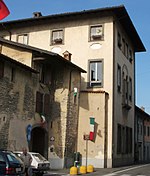Morla
BergamoRivers of ItalyRivers of the Province of BergamoTributaries of the Serio

Morla is a 16 km long river in province of Bergamo. Its source is located in Maresana in the municipality of Ponteranica, then Morla crosses the city of Bergamo, after Bergamo part of its waters are used in agriculture. One branch flows into the Serio near Orio al Serio.
Excerpt from the Wikipedia article Morla (License: CC BY-SA 3.0, Authors, Images).Morla
Via Lazzaretto,
Geographical coordinates (GPS) Address Nearby Places Show on map
Geographical coordinates (GPS)
| Latitude | Longitude |
|---|---|
| N 45.6666 ° | E 9.7293 ° |
Address
Tiro al Volo Bergamo
Via Lazzaretto
24068
Lombardy, Italy
Open on Google Maps










